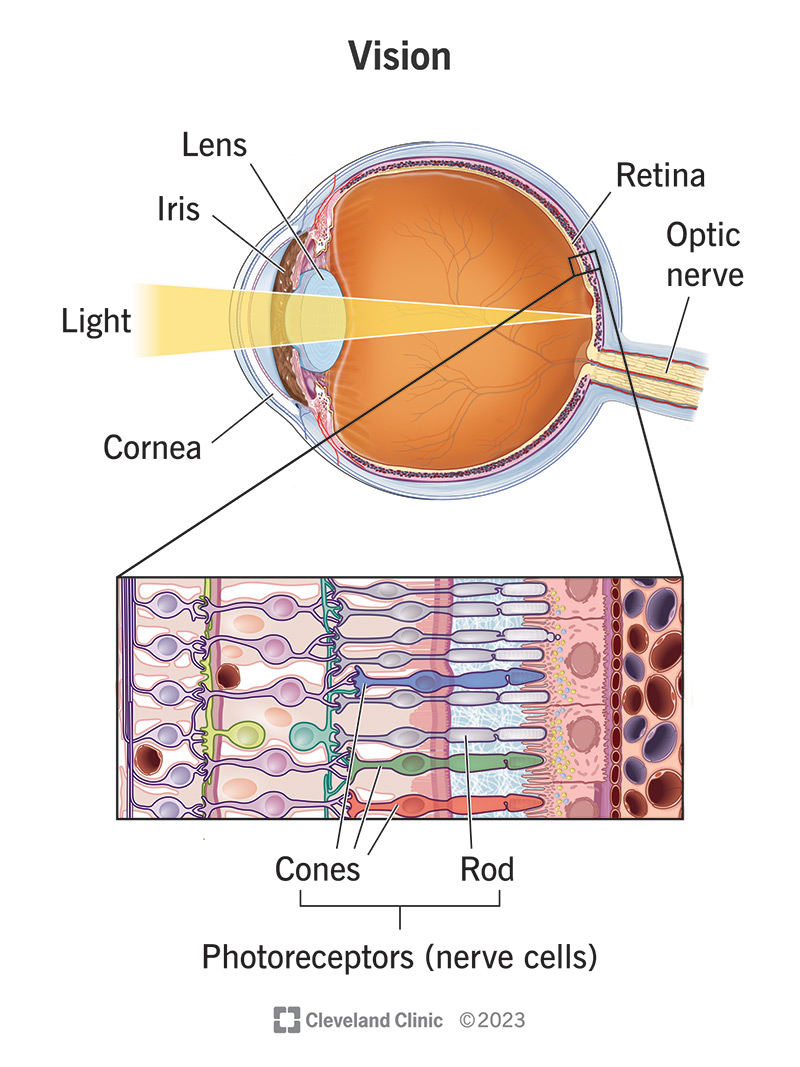Vision is the complex, multipart process that gives you your sense of sight. Vision itself doesn’t happen in your eyes. Instead, it’s the sum of your eyes, retinas, optic nerves and brain working together to process reflected light from the world around you. Maintaining your vision can make a big difference in your well-being and quality of life.
Advertisement
Cleveland Clinic is a non-profit academic medical center. Advertising on our site helps support our mission. We do not endorse non-Cleveland Clinic products or services. Policy

Vision is the process where your eyes and brain work together and use light reflecting off things around you to create the ability to see. It’s one of the five main senses and a key contributor to how most people understand the world around them.
Advertisement
Cleveland Clinic is a non-profit academic medical center. Advertising on our site helps support our mission. We do not endorse non-Cleveland Clinic products or services. Policy
Vision starts when your eyes detect light and turn it into coded nerve signals, which then travel through your optic nerves to your brain. Your brain receives and decodes the signals, and turns them into the pictures you see.
An easy analogy is to think of eyes like cameras, but it’s really the other way around. Cameras are an example of technology reverse-engineered from the human eye.
Cameras have lenses that focus light onto a special sensor inside the camera. That sensor converts light into electrical signals, and a special computer inside the camera translates those signals into the data that makes up the image file. You can also control the focus of a camera, and some cameras let you control how much light reaches the sensor.
Your eyes have lenses that focus light and direct it toward your retinas. Your retinas are like the sensor inside the camera, but far more sophisticated. They convert the light that lands on them into nerve signals and then send those signals to your brain. This happens dozens of times per second.
And the special capabilities of cameras, like focusing and light control, are also things your eyes do automatically. Your pupils can widen (dilate) or narrow (constrict) to control how much light enters your eyes. Muscles control your eyes’ lenses, changing how light rays come into focus for objects at varying distances.
Advertisement
Your retinas are highly specialized, very sensitive cells called photoreceptors (meaning “light receivers”). When light hits them, it triggers chemical and electrical reactions in the cells. That’s how those cells convert light and encode them into nerve signals.
There are two main types of photoreceptors:
Once converted into coded nerve signal form, your retinas transmit the signals to your optic nerves.
Your optic nerves are like data cables that link your retinas to various parts of your brain. The signals travel along the optic nerves to reach the various parts of your brain responsible for signal decoding and processing.
The last main step involves your brain. Your brain receives the coded signals carried along your optic nerves and decodes them. It then uses the decoded information to construct the “image” of what each eye sees.
Depending on what you see, your brain might have different areas working together to process and fully understand the picture. For example, reading a sentence like this also involves brain areas responsible for understanding language and recalling memories. That’s how you can understand the words, remember what they mean and use them to access related memories.
Vision involves multiple body parts and structures working together, and different conditions can affect each. Some conditions can affect more than one part of your visual system.
Examples of conditions that can affect your vision, depending on the affected part, include:
Many people, experts and scientists included, use the terms “vision” and “sight” interchangeably. But they aren’t necessarily the same thing. It’s possible to use your visual abilities without seeing something (like seeing images in your mind). There are also brain conditions that affect your ability to process what your eyes detect.
One way to break this down is to look at sight as a physical ability only. It refers to how your eyes detect light and turn it into electrical and chemical signals to send to your brain.
Vision, on the other hand, requires the ability to process signals from your eyes. Without that processing, the signals your eyes send to your brain aren’t useful.
While it might seem strange to think of them separately, there are brain conditions that can affect vision without disrupting sight. Examples include visual agnosia and other agnosia-type conditions. People with visual agnosia have functioning eyesight, but their brains can’t always process what they see. A specific example of this is face blindness (prosopagnosia). People with this condition can see faces but can’t recognize them.
Advertisement
There are several things you can do to maintain and protect your vision. Some of the most important to keep in mind include:
Advertisement
For most people, vision is the most important sense they use daily. While it might seem like a straightforward ability, it’s one of the most complex processes in your body. For your vision to work its best, all parts of your eyes, plus your retinas, optic nerves and brain, must work correctly and cooperatively. There are many things you can do to maintain and protect them. That way, you can focus more on what you want to see rather than concerns about whether or not you can see.
Advertisement
Getting an annual eye exam at Cleveland Clinic can help you catch vision problems early and keep your eyes healthy for years to come.

Last reviewed on 12/13/2023.
Learn more about the Health Library and our editorial process.